Controls
Here we focus on the impact of non-pharmaceutical controls (NPI) to reduce the transmission of COVID; vaccination is dealt with elsewhere. Such NPIs generally aim to limit the mixing between susceptible and infected individuals.
|
Hill, E.M. (2023) Modelling the epidemiological implications for SARS-CoV-2 of Christmas household bubbles in England. Journal of Theoretical Biology 557: 111331. DOI: 10.1016/j.jtbi.2022.111331 |
The emergence of SARS-CoV-2 saw severe detriments to public health being inflicted by COVID-19 disease throughout 2020. In the lead up to Christmas 2020, the UK Government sought an easement of social restrictions that would permit spending time with others over the Christmas period, whilst limiting the risk of spreading SARS-CoV-2. In November 2020, plans were published to allow individuals to socialise within "Christmas bubbles" with friends and family. This policy involved a planned easing of restrictions in England between 23-27 December 2020, with Christmas bubbles allowing people from up to three households to meet throughout the holiday period. Using a stochastic individual-based model for a synthetic population of 100,000 households, we estimated the epidemiological impact of both this and alternative bubble strategies that allowed extending contacts beyond the immediate household. We found that visiting family and friends over the holiday period for a shorter duration and in smaller groups was less risky than spending the entire five days together. The increases in infection from greater amounts of social mixing disproportionately impacted the eldest. The article is an illustration of a real-time contribution of modelling insights to a scientific advisory group, the Scientific Pandemic Influenza Group on Modelling, Operational sub-group (SPI-M-O) for the Scientific Advisory Group for Emergencies (SAGE) in the UK, during the COVID-19 pandemic.
| Leng, T., Hill, E.M., Keeling, M.J., Tildesley, M.J. and Thompson R.N. (2022) "The effect of notification window length on the epidemiological impact of COVID-19 contact tracing mobile applications" Communications Medicine 2:74. DOI: 10.1038/s43856-022-00143-2 |
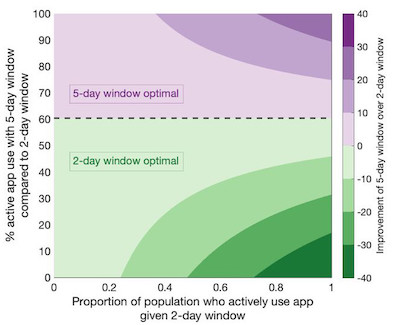 The reduction in SARS-CoV-2 transmission from contact tracing applications (apps) depends both on the number of contacts notified and on the probability that those contacts quarantine after notification. Referring to the number of days preceding a positive test that contacts are notified as an app’s notification window, we use an epidemiological model of SARS-CoV-2 transmission that captures the profile of infection to consider the trade-off between notification window length and active app-usage. We focus on 5-day and 2-day windows, the lengths used by the NHS COVID-19 app in England and Wales before and after 2nd August 2021, respectively. Short windows can be more effective at reducing transmission if they are associated with higher levels of active app usage and adherence to isolation upon notification, demonstrating the importance of understanding adherence to control measures when setting notification windows for COVID-19 apps.
The reduction in SARS-CoV-2 transmission from contact tracing applications (apps) depends both on the number of contacts notified and on the probability that those contacts quarantine after notification. Referring to the number of days preceding a positive test that contacts are notified as an app’s notification window, we use an epidemiological model of SARS-CoV-2 transmission that captures the profile of infection to consider the trade-off between notification window length and active app-usage. We focus on 5-day and 2-day windows, the lengths used by the NHS COVID-19 app in England and Wales before and after 2nd August 2021, respectively. Short windows can be more effective at reducing transmission if they are associated with higher levels of active app usage and adherence to isolation upon notification, demonstrating the importance of understanding adherence to control measures when setting notification windows for COVID-19 apps.
|
Hart WS, Maini PK, Thompson RN. (2021) High infectiousness immediately before COVID-19 symptom onset highlights the importance of continued contact tracing. eLife 10:e65534. DOI: 10.7554/eLife.65534 |
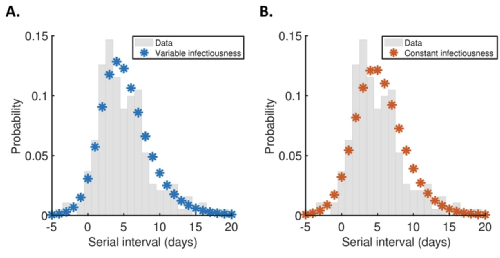 In this paper, we develop a novel mechanistic approach to infer the infectiousness profile of SARS-COV-2-infected individuals using data from known infector–infectee pairs. We compare estimates of key epidemiological quantities generated using our mechanistic method with analogous estimates generated using previous approaches.The mechanistic method provides an improved fit to data from SARS-CoV-2 infector–infectee pairs compared to commonly used approaches. Our best-fitting model indicates a high proportion of presymptomatic transmissions, with many transmissions occurring shortly before the infector develops symptoms.High infectiousness immediately prior to symptom onset highlights the importance of continued contact tracing until effective vaccines have been distributed widely, even if contacts from a short time window before symptom onset alone are traced.
In this paper, we develop a novel mechanistic approach to infer the infectiousness profile of SARS-COV-2-infected individuals using data from known infector–infectee pairs. We compare estimates of key epidemiological quantities generated using our mechanistic method with analogous estimates generated using previous approaches.The mechanistic method provides an improved fit to data from SARS-CoV-2 infector–infectee pairs compared to commonly used approaches. Our best-fitting model indicates a high proportion of presymptomatic transmissions, with many transmissions occurring shortly before the infector develops symptoms.High infectiousness immediately prior to symptom onset highlights the importance of continued contact tracing until effective vaccines have been distributed widely, even if contacts from a short time window before symptom onset alone are traced.
| Tildesley, M.J., Vassall, A., Riley, S., Jit, M., Sandmann, F., Hill, E.M., Thompson, R.N., Atkins, B.D., Edmunds, J., Dyson, L. & Keeling, M.J. (2022) "Optimal health and economic impact of non-pharmaceutical intervention measures prior and post vaccination in England: a mathematical modelling study" Roy. Soc. Open Science. https://doi.org/10.1098/rsos.211746 |
 Even with good progress on vaccination, SARS-CoV-2 infections in the UK may continue to impose a high burden of disease and therefore pose substantial challenges for health policy decision makers. Stringent government-mandated physical distancing measures (lockdown) have been demonstrated to be epidemiologically effective, but can have both positive and negative economic consequences. The duration and frequency of any intervention policy could, in theory, could be optimised to maximise economic benefits while achieving substantial reductions in disease.
Even with good progress on vaccination, SARS-CoV-2 infections in the UK may continue to impose a high burden of disease and therefore pose substantial challenges for health policy decision makers. Stringent government-mandated physical distancing measures (lockdown) have been demonstrated to be epidemiologically effective, but can have both positive and negative economic consequences. The duration and frequency of any intervention policy could, in theory, could be optimised to maximise economic benefits while achieving substantial reductions in disease.
In this work we use a SARS-CoV-2 transmission model to assess the health and economic implications of different strengths of control through time in order to identify optimal approaches to non-pharmaceutical intervention stringency in the UK, considering the role of vaccination in reducing the need for future physical distancing measures. We find that the precise timing and intensity of interventions is highly dependent upon the objective of control. As intervention measures are relaxed, we predict a resurgence in cases, but the optimal intervention policy can be established dependent upon the willingness to pay (WTP) per QALY loss avoided. Our results show that establishing an optimal level of control can result in a reduction in net monetary loss of billions of pounds, dependent upon the precise WTP value. We therefore demonstrate how future health and non-health harms associated with infectious disease outbreaks could be quantified, employing mechanistic infectious disease transmission models to establish optimal levels of control for the ongoing COVID-19 pandemic.
Figures: Optimal relaxation rate for the January 2021 lockdown in the UK (given by shaded grey regions) dependent upon the Willingness to Pay per QALY Loss avoided, W (£20.000 top to £50,000 bottom) and the rate of the vaccination campaign (pale lines indicate 2 million doses per week and darker lines indicate 4 million doses of vaccination per week).
| Leng, T., White, C., Hilton, J., Kucharski, A., Pellis, L., Stage, H., Davies, N., CMMID-Covid-19 WG, Keeling, M.J., Flasche, S. (2021) “The effectiveness of social bubbles as part of a Covid-19 lockdown exit strategy, a modelling study” Wellcome Open Res 5:213. https://doi.org/10.1268/wellcomeopenres.16164.2 |
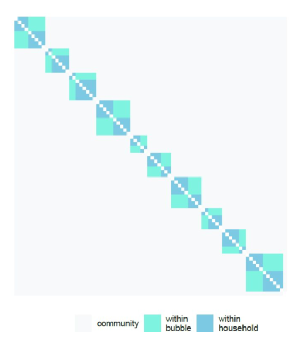
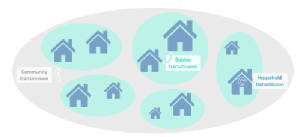 Social bubbles have been proposed as a means of allowing extended contacts beyond the household while minimising the associated transmission risks. The concept is that members of one household are allowed to meet exclusively with members of one other household - while this increases the risk of transmission the premise is that the bubble remains relatively isolated.
Social bubbles have been proposed as a means of allowing extended contacts beyond the household while minimising the associated transmission risks. The concept is that members of one household are allowed to meet exclusively with members of one other household - while this increases the risk of transmission the premise is that the bubble remains relatively isolated.
Our modelling work shows that social bubbles reduced cases and fatalities by 42% compared to an unclustered increase of contacts. Social bubbles may be extremely effective if targeted towards those small isolated households with the greatest need for additional social interactions and support.
Figures: examples of how households and social bubbles can be captured by a next generation matrix.
| Keeling, M.J., Guyver-Fletcher, G, Holmes, A., Dyson, L., Tildesley, M.J., Hill, E.M. and Medley, G.F. (2021) "Precautionary breaks: Planned, limited duration circuit breaks to control the prevalence of SARS-CoV-2 and the burden of COVID-19 disease" Epidemics https://doi.org/10.1016/j.epidem.2021.100526Link opens in a new window |
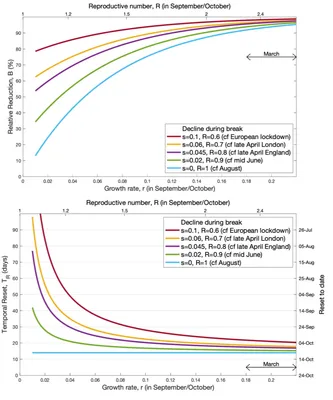 Research undertaken in October 2020 examined the potential of a "Circuit Breaker" to contain a growing epidemic.
Research undertaken in October 2020 examined the potential of a "Circuit Breaker" to contain a growing epidemic.
When cases of COVID-19 are rising exponentially, we consider the impact of a short 2-week period of intense control. Using two different modelling approaches we show that a short, sharp 2-week break leads to a decline in cases, with similar declines in hospitalisation and mortality over a short period - this could potentially reduce the acute load on the NHS enabling it to continue non-COVID care into the winter months.
A precautionary break is not a lasting control measure, but effectively buys more time to put other controls in place; it takes us ‘back to a time when cases were lower’.
To save lives over longer time scales requires driving R below one, however the reduction in cases generated by a circuit breaker allows time for other measures to have an impact and could be beneficial when measures are resource limited (such as test-trace-and-isolate).
| Keeling, M.J., Hollingsworth, T.D. & Read, J.M. (2020) "The Efficacy of Contact Tracing for the Containment of the 2019 Novel Coronavirus (COVID-19)" J. Epidemiology & Community Health 74 (10). http://dx.doi.org/10.1136/jech-2020-214051 |
Co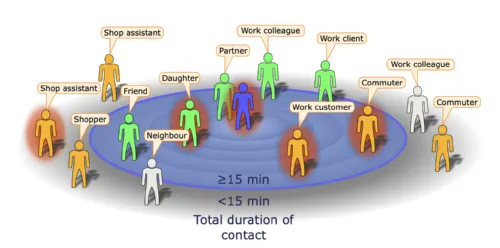 ntact tracing together with testing is viewed as a necessary tool in the relaxation of lockdown methods. Work by SBIDER, in collaboration with Oxford and Lancaster Universities, considered the use of contact tracing in the early stages of the outbreak as a means of controlling or containing the pandemic in the UK.
ntact tracing together with testing is viewed as a necessary tool in the relaxation of lockdown methods. Work by SBIDER, in collaboration with Oxford and Lancaster Universities, considered the use of contact tracing in the early stages of the outbreak as a means of controlling or containing the pandemic in the UK.
The figure shows a cartoon of contact tracing around a central infected figure (blue); some individuals are known to the index case and match the tracing criteria (green), others are known but contact time is considered too short (grey), but some contacts are unknown and hence untraceable (orange).
Before lockdown, each person had many contacts that were made over a 7-day period (mean contacts 216, mean contacts to trace 36), so contact tracing logistics could soon be overwhelmed with just a few infectious cases.
If we are able to trace all the contacts meeting the close contact definition, then our results show that an outbreak could be contained, although the "untraceable" contacts could still give rise to a low number of secondary cases.
